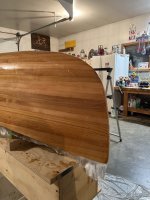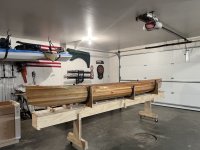Yes, I put the football on top of the main layer of glass. I’m not too concerned with getting that right. More so on the extra glass I put on the stems.
I usually cut my stem strips about 4 inches wide, with the weave at a 45 degree angle (bias cut).
This way, the stem pieces can easily conform to the compound curves at the bow and stern stems.
Also, since the glass fibers are at the 45 degree angle, they tend to NOT pull out or fray, the way straight cut cloth edges do.
Here's a look at wetting out one of the stems...BTW, these stem strips were applied to the freshly wetted out hull, all of the resin was still completely uncured.
I laid the bias cut strip over the stems and tug from each end. This coerces the cloth to partially wrap around the stems immediately.
Then, I roll the stem strip into place along the apex of the stem.
Then, I begin rolling the stem strip into place along the sides, starting at the apex of the stem. I alternate sides before working toward the sheer and keel lines.
Since the glass fibers are at that 45 degree angle, they easily conform.
Last pic shows the Dynel cloth laid into place as a wear strip.
Lastly, yeah, that's my jokester son getting ready to lick that resin, such a funny guy. He's been helping me glass boats since he was 7 years old...








